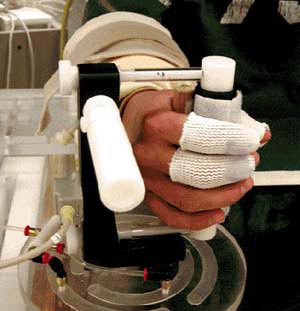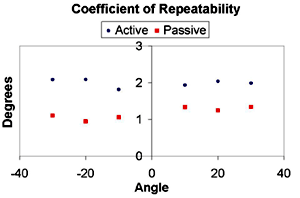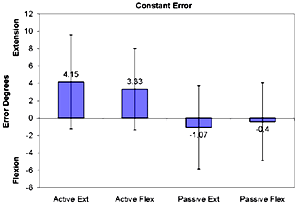The Clinical Role of Wrist Joint Mechanoreceptors

Figure 1: Subject's hand positioned in manipulandum with the electromagnetic sensor attached on the left side of the upright and extension protruding from the front of the upright.

Figure 2: Constant error associated with active and passive conditions. The principal effect of passive versus active condition was statistically significant (p<.0001).
-
Figure 3: Summary data for passive and active conditions by angle. Note: Flexion angles are denoted as negative (-) and extension angles as positive (+). If there were no constant error, boxes would be centered around the horizontal line indicating the corresponding target position.

Figure 4: Repeatability coefficients between repeated trials at specific angles. The repeatability coefficient indicates the degrees of variability between two trials at the same angle in a given condition (active or passive). The repeatability coefficient indicates that the examiner consistently placed the wrist at a position within approximately 2° or less between trials.
Principal Investigator: Richard A. Berger, M.D.
Project Coordinator: Evelyn Berger — berger.evelyn@mayo.edu
The specific purpose of the current study is to determine the effect of diminished or absent joint capsular afferent input on wrist proprioception. The experimental set-up used an air bearing supported manipulandum which limited wrist motion to the flexion/extension axis (Fig. 1). An electromagnetic tracking system provided joint position data. Visual and aural feedback were eliminated. Tactile proprioceptive feedback were minimized. In the present study, a local anesthetic in the region of the AIN and PIN is used to block joint mechanoreceptor afferent signals without affecting other proprioceptive systems. The hypothesis is that there will be a quantifiable change in acuity of static wrist position sense by blocking the anterior and posterior interosseous nerves.
When comparing averaged passive versus active motion, an ANOVA with repeated measures revealed significant differences between the passive and active conditions in constant (p<0.0001) and absolute (p=0.0084) error. Average constant error in the passive condition was -0.7° +/- 4.7° as compared to the active condition at 3.7° +/- 5.1°. Average absolute error in the passive condition was 4.9° +/- 2.9° compared to the active condition in which absolute error was 5.9° +/- 3.5°. Variable error in the active and passive conditions were not significantly different (passive = 4.2° +/- 2.6°; active = 4.6° +/- 2.9°; p=.1720). The power to detect
differences from 2.7°-3.6° was
calculated to be 90%.
The data were then separated into categories of active flexion, active extension, passive flexion and passive extension (Fig. 2). Statistically significant differences (p<0.0001) were detected between passive versus active testing conditions, regardless of the direction of motion. There were no significant differences between directions of motion, regardless of testing condition. The data suggest an "overshoot" phenomenon during active testing conditions, whereby the subject passes the target position, compared to the passive testing conditions.
Further separation of the data into groups defining 10° increments of flexion and extension was completed (Fig. 3). In the passive condition, median angles reproduced were closer to the target angles at each position than in the active condition. This finding held regardless of direction of motion or joint position. These data also demonstrate an "overshoot" phenomenon during active testing. Repeatability coefficients calculated between wrist placements in two repetitions of each angle are depicted in Figure 4. This coefficient indicates that the examiner placed the wrist at a position within 2° between the two repetitions.